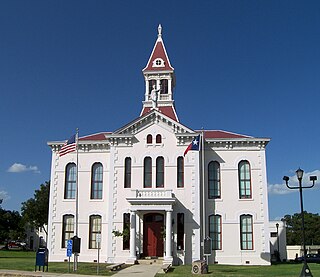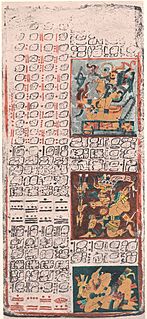English usually refers to:

The Kickapoo People are an Algonquian-speaking Native American and Indigenous Mexican tribe. Anishinaabeg say the name "Kickapoo" means "Stands here and there," which may have referred to the tribe's migratory patterns. The name can also mean "wanderer". This interpretation is contested and generally believed to be a folk etymology.

Texas is a state in the South Central Region of the United States. It is the second largest U.S. state by area and population. Texas shares borders with the states of Louisiana to the east, Arkansas to the northeast, Oklahoma to the north, New Mexico to the west, and the Mexican states of Chihuahua, Coahuila, Nuevo León, and Tamaulipas to the southwest, and has a coastline with the Gulf of Mexico to the southeast.

Wilson County is a county located in the U.S. state of Texas. As of the 2010 census, its population was 42,918. Its county seat is Floresville. The county is named after James Charles Wilson.

Victoria County is a county located in the U.S. state of Texas. As of the 2010 census, its population was 86,793. Its county seat is Victoria.

DeWitt County is a county located in the U.S. state of Texas. As of the 2010 census, its population was 20,097. The county seat is Cuero. The county was founded in 1846 and is named for Green DeWitt, who founded an early colony in Texas.
Texas German is a group of German language dialects spoken by descendants of German immigrants who settled in Texas in the mid-19th century. These "German Texans" founded the towns of Bulverde, New Braunfels, Fredericksburg, Boerne, Walburg, and Comfort in Texas Hill Country, Muenster in North Central Texas, and Schulenburg, Brenham and Weimar to the east.

Indigenous languages of the Americas are spoken by indigenous peoples from Alaska, Nunavut, and Greenland to the southern tip of South America, encompassing the land masses that constitute the Americas. These indigenous languages consist of dozens of distinct language families, as well as many language isolates and unclassified languages.
The United States has 41 million people aged five or older who speak Spanish at home, making Spanish by far the second most spoken language of the United States. Spanish is the most studied foreign language in the United States, with about six million students. With over 50 million native speakers, heritage language speakers, and second-language speakers, the United States now has the second largest Spanish-speaking population in the world after Mexico although it is not an official language of the country. About half of all American Spanish speakers also assessed themselves as speaking English "very well" in the 2000 US Census. That increased to 57% in the 2013–2017 American Community Survey. The United States is among the Spanish-speaking countries that has its own Academy of the Spanish Language.

The Caddoan languages are a family of languages native to the Great Plains. They were spoken by tribal groups of the central United States, from present-day North Dakota south to Oklahoma. In the 21st century, they are critically endangered, as the number of native speakers has declined markedly.
The Chʼol (Chol) language is a member of the western branch of the Mayan language family used by the Chʼol people in the Mexican state of Chiapas. There are two main dialects:
Coahuiltecan was a proposed language family in John Wesley Powell's 1891 classification of Native American languages. Most linguists now reject the view that the Coahuiltecan peoples of southern Texas and adjacent Mexico spoke a single or related languages. Coahuiltecan continues to be a convenient collective term for the languages and people of this region.

Comecrudan refers to a group of possibly related languages spoken in the southernmost part of Texas and in northern Mexico along the Rio Grande of which Comecrudo is the best known. Very little is known about these languages or the people who spoke them. Knowledge of them primarily consists of word lists collected by European missionaries and explorers. All Comecrudan languages are extinct.
Of the languages spoken in Texas none have been designated the official language. As of 2005, around 66.36% of residents speak English at home with around 29.10% speaking Spanish at home. Throughout the history of Texas, English and Spanish have at one time or another been the primary dominant language used by government officials, with German recognized as a minority language from Statehood until the first world war.

Oasisamerica is a term that was coined by Paul Kirchhoff and published in a 1954 article, and is used by some scholars, primarily Mexican anthropologists, for the broad cultural area defining pre-Columbian southwestern North America. It extends from modern-day Utah down to southern Chihuahua, and from the coast on the Gulf of California eastward to the Río Bravo river valley. Its name comes from its position in relationship with the similar regions of Mesoamerica and mostly nomadic Aridoamerica. The term Greater Southwest is often used to describe this region by American anthropologists.
Texas is the second most populous U.S. state, with an estimated July 2018 population of 28.702 million. In recent decades, it has experienced strong population growth. Texas has many major cities and metropolitan areas, along with many towns and rural areas. Much of the population is in the major cities of Houston, San Antonio, Dallas, Fort Worth, Austin, and El Paso.

The Aranama were an indigenous people who lived along the San Antonio and Guadalupe rivers of modern Texas. Many Aranama people moved to Mission Nuestra Señora del Espíritu Santo de Zúñiga at its second and third locations.

The indigenous peoples of the North American Southwest are those in the current states of Colorado, Arizona, New Mexico, Utah, and Nevada in the western United States, and the states of Sonora and Chihuahua in northern Mexico. An often quoted statement from Erik Reed (1964) defined the Greater Southwest culture area as extending north to south from Durango, Mexico to Durango, Colorado and east to west from Las Vegas, Nevada to Las Vegas, New Mexico. Other names sometimes used to define the region include "American Southwest", "North Mexico", "Chichimeca", and "Oasisamerica/Aridoamerica". This region has long been occupied by hunter-gatherers and agricultural people.










